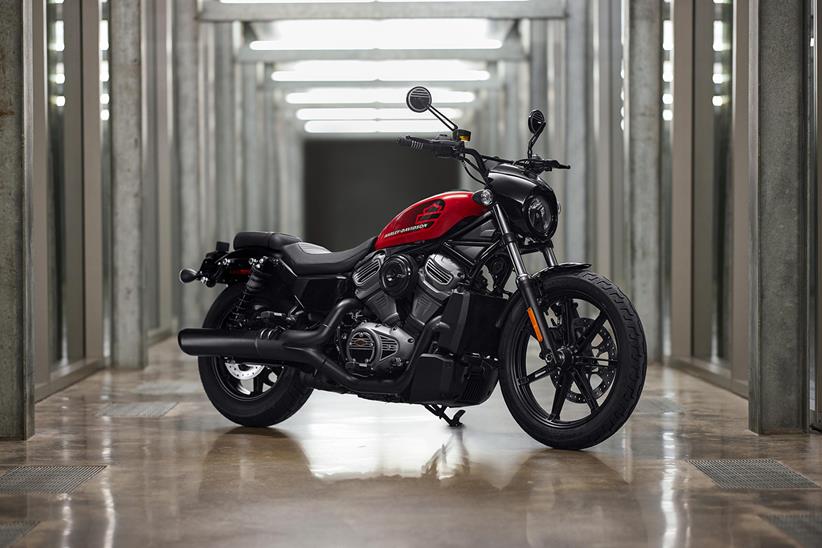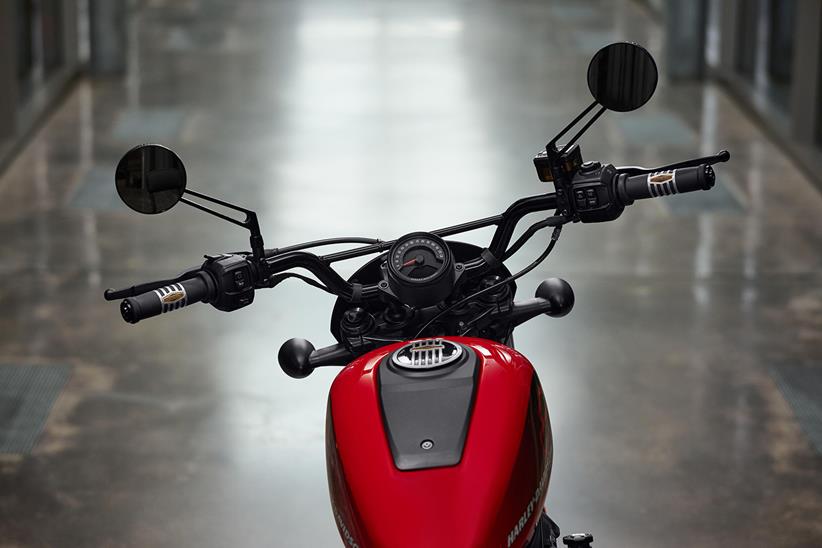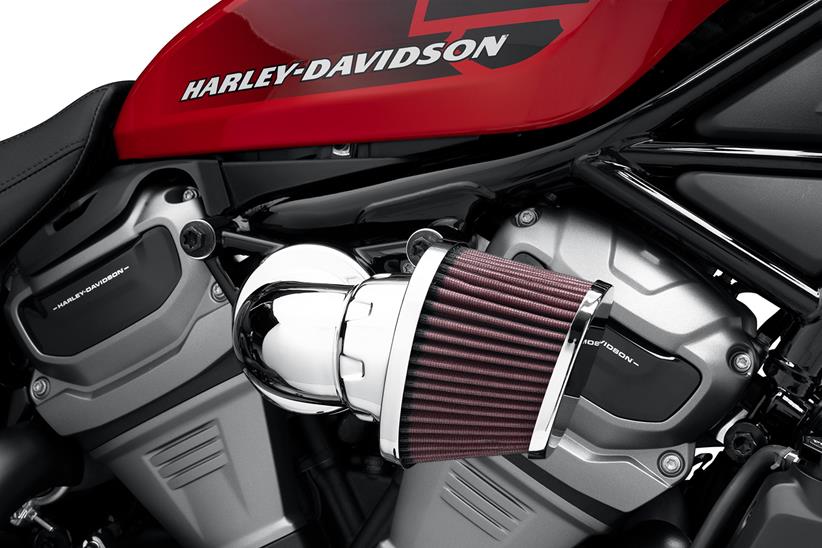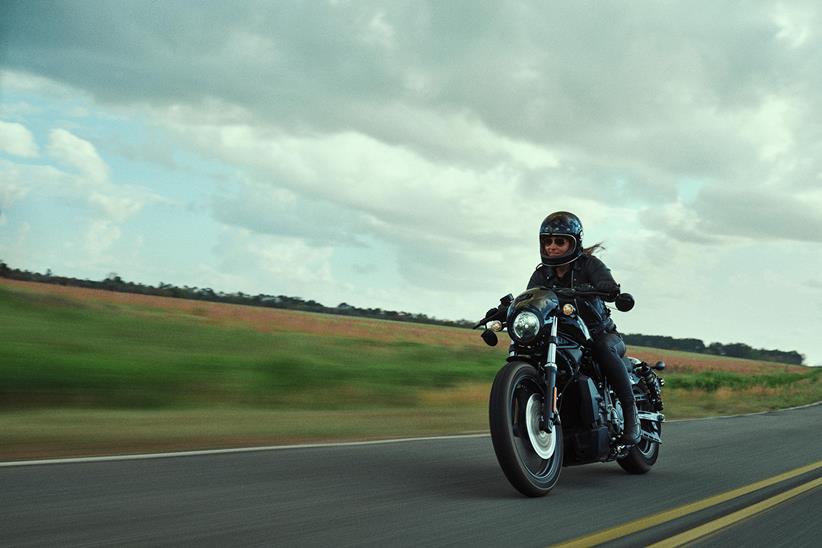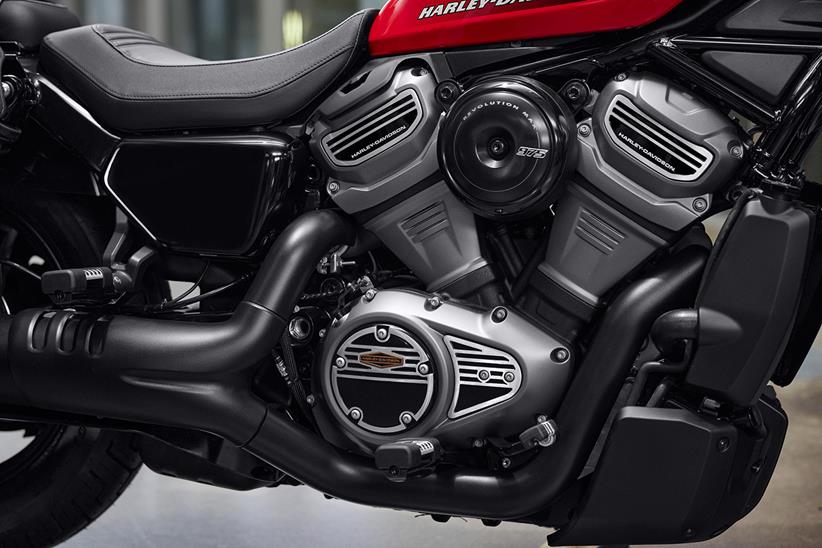Harley-Davidson Nightster: New entry-level water-cooled Sportster model replaces iconic 883
Sixty-five years after the first Sportster, Harley-Davidson have produced their first water-cooled entry-level model, which also rekindles the Nightster name in the range.
Pulling off the same trick as most of the Harley range, the new Nightster works hard to look authentically ‘heritage’, while actually boasting a decent raft of high-end tech, clever packaging solutions and electronic rider assistance.
Related articles on MCN
- Harley-Davidson Sportster S review
- Expansive removal of tariffs good news for Harley
- How the Harley-Davidson Fat Boy put the firm back on the map
At its core – literally and structurally – is the debut of the new 975cc version of the firm’s Revolution Max engine platform, first seen in 1250 guise on the Pan America. This new 60° liquid-cooled V-twin is developing a claimed 88.5bhp at 7500rpm, and a punchy 70lb.ft torque at 5000rpm from its 97mm bore and 66mm stroke.
While the 1250T has variable valve timing on both inlet and exhaust valves, the new 975T only uses VVT on the inlet cam. Speaking to MCN ahead of its unveiling, Kyle Wick, Chief Engineer, told us: “Every situation and characteristic of the engine is about getting the right balance.
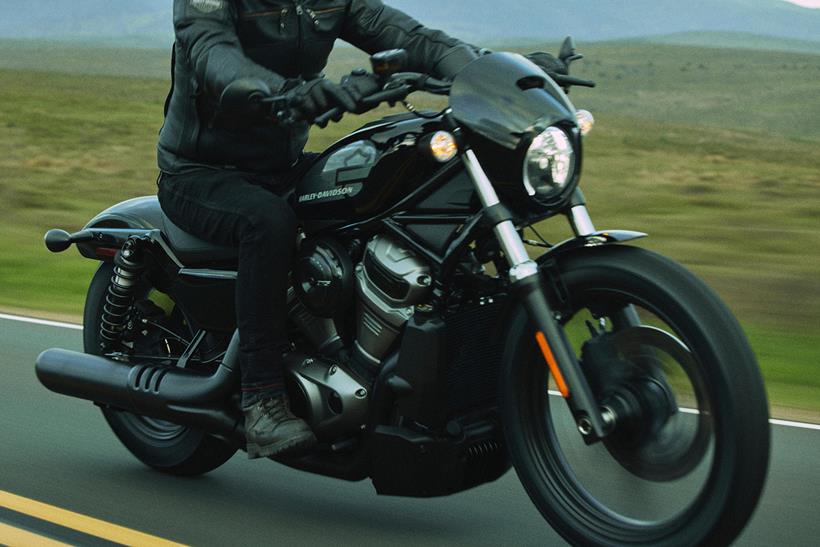
“We knew what performance goals we were targeting, and it didn’t lend itself to requiring the added technology, complexity, weight and cost of the added phaser [VVT] on the exhaust valves. The benefit wasn’t worth trading off all of that. This was the right way to package the engine to reach the performance goal we were chasing.
“Having VVT on the intake helps us with tougher emissions regulations, and does help us to maximise the engine performance in a way you can’t get with fixed cam timing. It’s a seamless, completely smooth transition as the cam timing changes.”
VVT also helps deliver the broad spread of power the design team were looking for, as well as improving fuel consumption (to a claimed 55mpg), while the 975T does away with the 1250T’s dual-spark heads to rely on single sparkplugs for each cylinder.
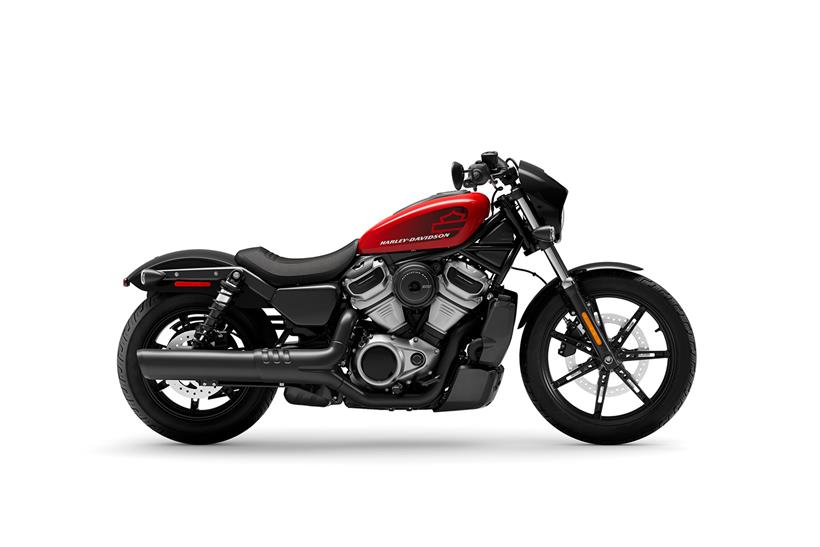
So why a 975cc engine capacity? “If you take the engine capacity numbers off the existing 883 and 1200 Sportster range, and concentrate on the desired performance, then introduce the Revolution Max engine platform, that led us to a displacement of 975cc to deliver that,” says Wick.
Vice President of Style & Design, Brad Richards, picks up the thread: “Having a compact unit with compact head and small exhaust and smaller radiator all helps to keep the silhouette balanced.
“There is always creative tension within the process. From a design perspective I was trying to eliminate the radiator while Kyle was trying to keep it to stop the engine from melting! We had several iterations of radiator size and tried several positions, and we ended up smaller than we started, which is great.

“Also, it is slightly tactical as the bikes do look a little odd now there is no loop frame. Without something ahead of the engine, the radiator is functional, but also visually holds the whole motorcycle together in terms of style and shape.
“We had to deal with it, because it allows us to take Sportster performance to a whole new level, and we felt it was time for us to step up the performance to a whole new level for our customers.”
The compact 975T unit also features hydraulic valve lash adjustment, eradicating the need for inevitably pricey valve services, while internal balancers are claimed to deliver significantly reduced vibration – boosting rider comfort. If the 975 follows its big brother’s character, it should be superbly smooth with a slick-shifting gearbox, too.
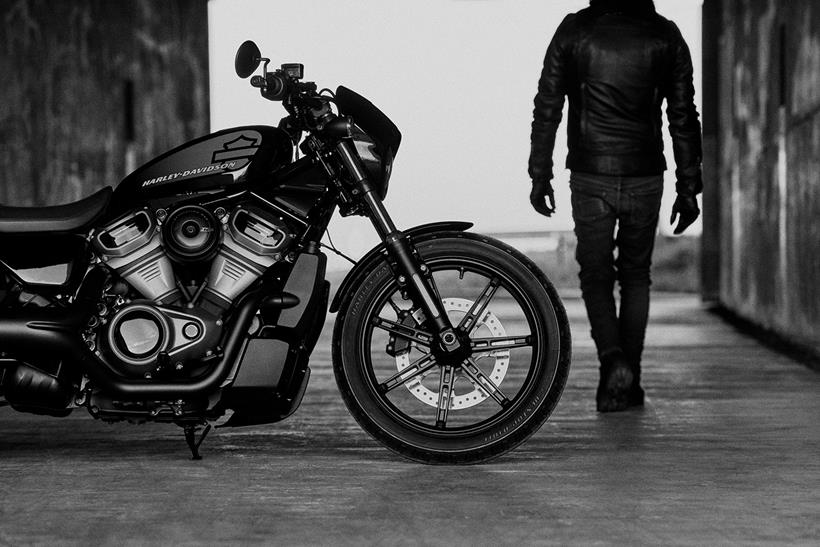
H-D’s new-found obsession with weight loss drove them to use single-piece aluminium cylinders with nickel silicon carbine-surface galvanic coating and rocker covers, camshaft cover and primary cover all made of magnesium.
Driving customisation
The engine also forms the central structural chassis component, acting as the core to which front, central and rear subframes are bolted – allowing huge potential for bolt-on/bolt-off customisation that wouldn’t previously have been possible without an angle grinder. While this has clear benefits, it also posed a challenge for the H-D design team.
Brad Richards told us: “Having a loop frame traditionally defined a lot of the form of the Sportster because we were locked into certain contact points for major componentry. We knew we wanted to take weight out, so that meant the engine would be load-bearing, effectively becoming the frame, and that was great from a performance and engineering standpoint, but we didn’t know if from a design standpoint we could capture the classic Sportster silhouette.”
“But having a modular frame is a real enabler and really liberating. Suddenly, for a relatively inexpensive investment we can change steering head angle, size of the rear module… Before that, it was a whole new frame, but now it’s a relatively small component to modify.”
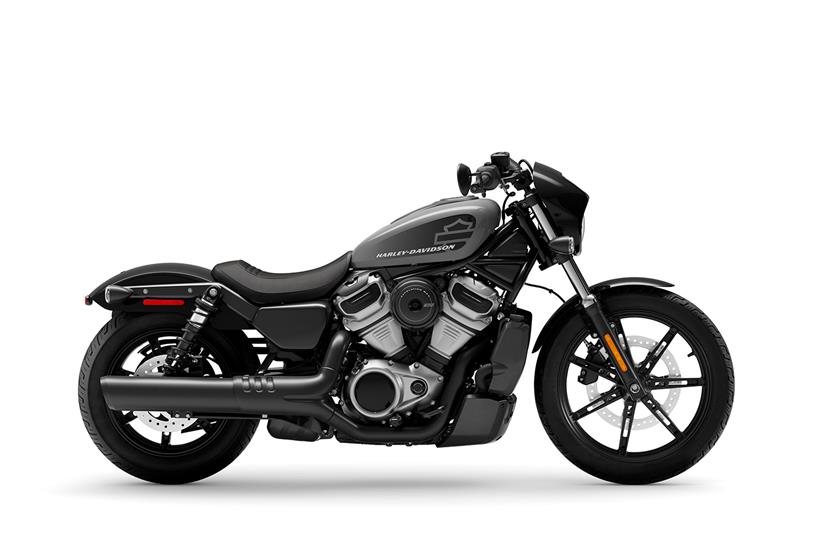
Recognising that most owners won’t resort to bespoke solutions, there’s already a decent catalogue of parts and accessories available for the Nightster allowing owners to take their bike in whatever direction they prefer – from traditional custom-and-chrome to a more laid-back touring cruiser – complete with screen, forward foot controls, rigid bags and sissy bar.
Tanking around
One of the clever packaging solutions on the Nightster is the positioning of the 11.7l fuel tank beneath the rider. H-D’s design team felt it would be too radical to do away with the traditional ‘walnut’ fuel tank – so it’s still there, in steel, and looking every bit the normal arrangement. Only the closed-off filler blank hints at what doesn’t lie beneath.
Brad Richards again: “The other big issue was that because of the performance requirements of the powertrain, and because the Sportster is known for its small walnut and peanut style tanks, we couldn’t combine the airbox and fuel cell in one spot. We tried it, but the tank was then too large, and it just didn’t look like a Sportster.

“So, the solution was to do what we did on V-Rod, and put the fuel cell under the rider. That allowed us to get all the airbox volume we needed, and to get the fuel tank capacity we needed.
“An XL is one of the most durable motorcycles, so keeping the walnut tank in steel was important. We didn’t want to cheapen the bike, and we talked about using plastic but it wasn’t the right move for Nightster at all.
“We also realised that there are some interesting benefits of taking the fuel from on top of the engine to under the seat in terms of potential customization because owners would be able to make radical form changes without having to deal with a conventional fuel tank.”
Kyle Wick added: “We were chasing a huge weight reduction, and that weight reduction was such an important part of this motorcycle and we wanted it to be accessible, fun to ride and with a great power-to-weight ratio.
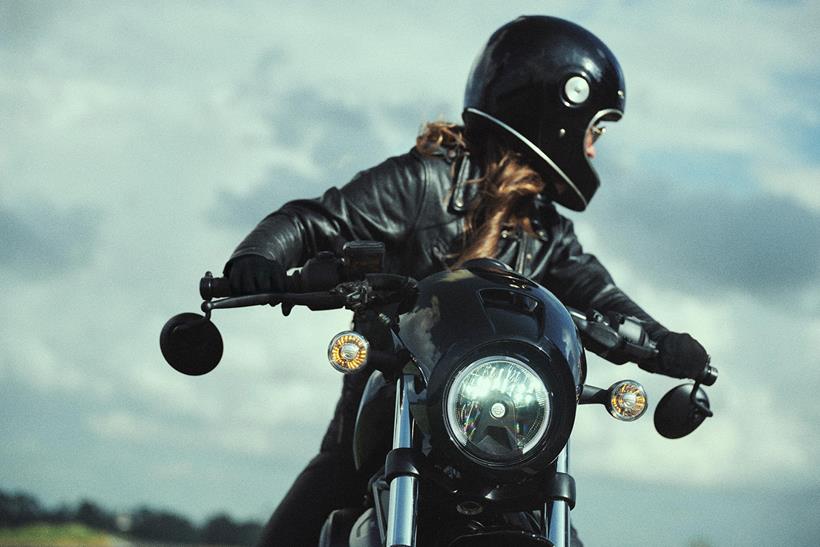
“So the design challenge was holding on to that weight reduction while connecting to that Sportster heritage in the way that we wanted to. The fuel tank was the biggest challenge we had, as we also wanted to keep the seat height very accessible, too.”
With the fuel cell now directly beneath the rider, that means you have to hop off to fill up, the filler being located under the lockable hinged rider’s seat (you’ll also find a shock preload spanner under there).
The significant benefits to the subterfuge are an optimised airbox without creating a bigger tank area – allowing for a sleek, low-profile silhouette, while also getting circa 12kg of full-tank mass lower in the package.
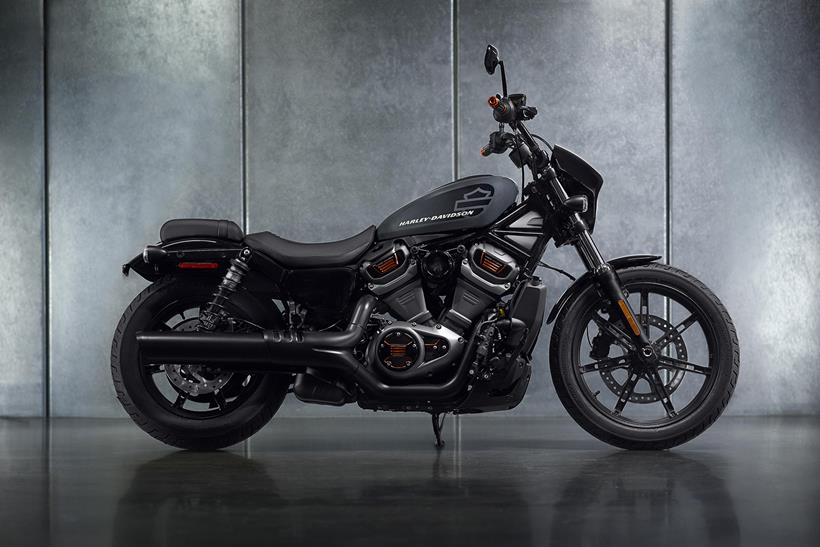
Sit on the Nightster and bring it upright off the sidestand, and you’d never guess at its 221kg mass – it feels tangibly lighter – while the 705mm seat height and narrow waist means flat-footed accessibility for a huge range of riders.
Safety net
Rider modes arrive in the form of three different settings: Road, Sport and Rain. Road is intended for daily use and delivers a softer throttle response and less mid-range engine power than Sport Mode, with a higher level of ABS and TC intervention.
‘Sport’ gives you everything the RevMax has got with TC set to its lowest level, and engine braking increased. ‘Rain’ knocks the power right back, reduces engine braking and selects the highest levels of ABS and TC.
The ABS isn’t linked or cornering-sensitive, but is adjustable via the modes, while the traction control is also mode-linked, but can be deactivated in any mode when at a standstill. The ‘Drag-Torque Slip Control System’ (DSCS) also helps to reduce rear-wheel lockups under hard deceleration.
The rise and fall
The conventional ‘right way up’ fork is Showa’s 41mm Dual Bending Valve unit, while the twin rear shocks are also Showa hardware (with 4.5in front and 3in rear travel). The only adjustment is preload on the rear shocks – there’s a shock spanner under the seat.
While the spec might seem relatively basic, this wasn’t a decision borne purely out of keeping the cost down. Kyle Wick: “Adventure-touring riders want all that adjustability and all that tech as they really understand it all and their riding conditions vary drastically, so it’s the right thing for them.
“In the space that Nightster operates in, there’s a lot of value to the rider in keeping it simple, and not trying to confuse them. It’s about a balance of providing enough to allow the customer what they need – so preload on the rear for carrying a pillion or luggage – so the improvement as a whole, with the suspension and increased travel, delivers added comfort.”
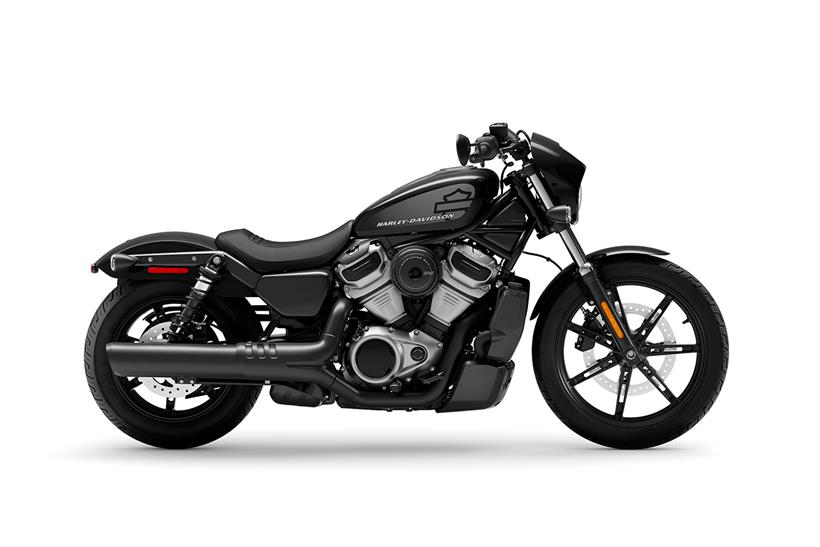
Hanging off the Showa hardware is a 19in front rim running a 100/90 R19, while the rear runs a 16in 150/80 R16 – using Harley-Davidson branded Dunlop D401 rubber.
A classic package
The round air intake cover, solo seat, walnut tank, chopped fenders, RWU fork and twin rear shocks and small front cowl all feel Sportster redolent, while the shrouded radiators clearly don’t. But the design team have done an admirable job of keeping that iconic Sportster silhouette instantly recognisable.
The colour palette is limited in scope and use, with the base Vivid Black joined by Gunship Grey and Redline Red – but those options (costing £375 extra) only colour the fake tank, all other painted surfaces stay black.
All the lighting is LED, while the 4in round clock unit is a classy mix of analogue and LCD information – but sadly doesn’t boast the connectivity seen on the Sportster S.
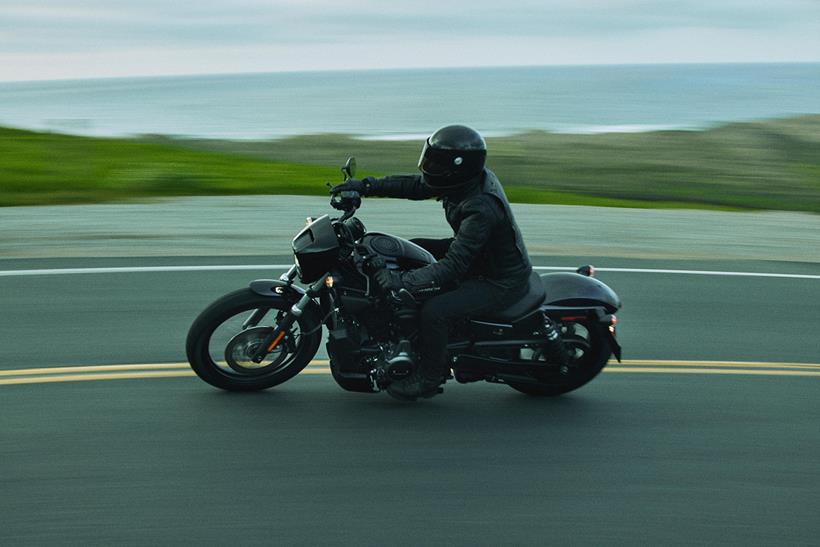
First impressions
So, is the new Nightster likely to move your soul? Well, on first impressions with both the black and red models in the flesh – yes. The Nightster looks beautifully proportioned, and feels it, too.
There’s plenty of room on board without any sense of being stretched in any one axis of the rider triangle; lift it off the sidestand and it springs upright without even the vaguest hint of its 221kg mass; and everything looks and feels pure high-end Harley.
Yes, the lack of connectivity is a shame. Yes, there’s a bit of a messy wiring nest down the left-hand side near the rear of the radiator. Yes, anyone conditioned to the price of the old 883 is going to baulk at the £13k price tag (although the price appears spot-on against its nearest competition in the market, Indian’s Scout).

But before we’ve been able to thumb the starter and take it anywhere, these are the only obvious niggles amidst an overwhelmingly endearing package.
The Nightster can be ordered at your local dealer now, while bikes are expected to arrive in late June/early July. If you’re already sold on the Nightster’s charms, be quick – less than 250 units are destined for UK shores this year.
The first UK bikes can be seen in the metal at the MCN Festival, while a full first UK ride will land here imminently to reveal whether the new Nightster goes as well as it looks.
2022 Harley-Davidson Nightster Technical Specifications
Engine
Type: 975cc liquid-cooled 60-degree Revolution Max 975T
Engine power: 88.5bhp @ 7500rpm
Engine torque: 70lb.ft @ 5000rpm
Bore & Stroke: 97mm x 66mm
Compression Ratio: 12:01
Chassis
Front brake: Axially mounted, 4-piston caliper, single disc
Rear brake: Floating single piston caliper, single disc
Front suspension: 41mm non-adjustable Showa Dual Bending Valve RWU forks
Rear suspension: Twin suspension shocks, preload adjustable
Front tyre: Dunlop D401 100/90-19 57H
Rear tyre: Dunlop D401 150/80B16 77H
Rake x Trail: 30° x 137mm
Wheelbase: 1545 mm
Weight: 221kg (wet)
Fuel capacity: 11.7litre
Seat Height: 705mm
